#book: a short history of cambodia
Note
i saw your post about your recommended nonfiction books and can’t wait to read them! would you happen to have any more you suggest? i love learning about the world and how others perceive it ❤️
oh yes i have sooooo many nonfiction recs......it's probably my favourite genre tbh, i try to always read 1 non-fiction for every fiction book i read.
"a natural history of love" and "a natural history of the senses" by diane ackerman. i'm also currently reading her book "the moon by whalelight (and other adventures among bats, penguins, crocodilians, and whales)". she is the most evocative nonfiction writer on planet earth.
i recommended this in my last list but "underland" by robert macfarlane.
"everybody: a book about freedom" by olivia laing - a very good book by a very good writer. queer history, gay liberation, women's rights, reproductive rights, what does it mean for a body to be 'free'.
mary roach, overall, is a very good and very funny non-fiction writer. i've read "spook" (about ghosts and the afterlife) and "fuzz" (about animals and the law) so far, both such good books.
"all about love" by bell hooks. tbh anything by bell hooks.
"the body in pain" by elaine scarry. not for everyone. it's a study on torture and pain and how pain makes and unmakes the world. i read it for a paper i had to write in grad school because i've always been interested in literary trauma theory and it was so informative. also, maggie nelson's "the art of cruelty" and susan sontag's "regarding the pain of others".
"freedom is a constant struggle" by angela davis. so much i could say about this book - it's not dense, it tackles so so much like palestine, prison abolition, the anti-apartheid movement in south africa, and so much more.
anything by rebecca solnit, but start with "hope in the dark" or "the mother of all questions".
"SPQR" by mary beard. if you are at all interested in roman history, this is where to start.
"a short history of nearly everything" by bill bryson is also a very good like....introductory / condensed history book. so so interesting!!
now i haven't read this quite yet but i'm soooooo excited to read "the dawn of everything: a new history" by david graeber and david wengrow.
"four lost cities" by annalee newitz. this book looks at the ancient cities of pompeii in italy, çatalhöyük in turkey, cahokai in the americas, and angkor in cambodia, and delves into how people lived in these cities and how they were built and used. very cool!!!
most of these are history or cultural conversations because those are my favourite non-fiction books to read (i'm not really a big memoir/biography girl). i left off some of my favourite literary criticism books because idk how many people care about that, but if you want those recs lmk!
92 notes
·
View notes
Text

Today In History
Zadie Smith is an amazing author, essayist, and short-story writer, who was born on this date October 25, 1975, in London, England.
Smith is the author of the novels White Teeth, The Autograph Man, On Beauty, NW and Swing Time, as well as a novella, The Embassy of Cambodia, and two collections of essays, Changing My Mind and Feel Free. She is also the editor of The Book of Other People.
Zadie was elected a fellow of the Royal Society of Literature in 2002, and was listed as one of Granta’s 20 Best Young British Novelists in 2003 and again in 2013.
Known for her eccentric characters, savvy humour, and snappy dialogue which tackle the treatment of race, religion, and cultural identity, Zadie Smith became a sensation in the literary world.
CARTER™️ Magazine
#carter magazine#carter#historyandhiphop365#wherehistoryandhiphopmeet#history#cartermagazine#today in history#staywoke#blackhistory#blackhistorymonth#zadie smith
36 notes
·
View notes
Text
My media this week (16-22 Jun 2024)

fuck this heat dome for reals
📚 STUFF I READ 📚
🥰 The Settler (charlesdk) - Stucky Book Club pick - 52K, shrunkyclunks, Steve retires & buys a farm, Bucky's the local baker. I really enjoyed this fic - though it is unrealistic fantasy about both small towns and owning a farm so YMMV. As I said in book club, I didn't have any problems doing the hand-wavey "escapist unbelievable small town/farm fantasy of it all" bc Steve's feelings & character were more my (and the author's) focus than his occupation & location. You could really feel Steve's exhaustion and emotions, and I loved the way Sam & Natasha were shown-not-just-told as his family. But also I don't have any deep personal resonance with this setting, other than recognizing it's unrealistic.
🥰 The Marlow Murder Club (The Marlow Murder Club #1) (Robert Thorogood, author; Nicolette McKenzie, narrator) - really entertaining small British village cozy mystery with very enjoyable characters. Had such a blast reading it! The mystery puzzle wasn't difficult to guess but that's not why I read cozies, and it was satisfactory in its twists & turns & fair play.
🥰 Civilians, GDI (relenafanel) - I love it when an author writes an AU of their own fic! AU of The Steve Rogers Problem with SHIELD agent!Bucky & actor!Steve except this time it's a meet ugly and Bucky's a dumbass about his own feelings
😊 The Theory Of Attraction (Delphine Dryden) - novella - good femsub D/s rec'd by the discord. Very satisfactory.
😊 Four Lost Cities: A Secret History of the Urban Age (Annalee Newitz, author; Chloe Cannon, narrator) - nonfiction; "explores the rise and fall of four ancient abandoned cities, each the center of a sophisticated civilization: the Neolithic site of Çatalhöyük in Central Turkey, the Roman vacation town of Pompeii on Italy’s southern coast, the medieval megacity of Angkor in Cambodia, and the indigenous metropolis Cahokia that stood beside the Mississippi River where East St. Louis is today." really interesting and well told (although tbh the narrator sounded a bit AI (but definitely wasn't))
🙂 The Pure and Simple Truth (lettered) - 65K, ostensibly drarry (but in the way that lacroix is ostensibly fruit flavored) - really about all the friendships & how people, the world, and redemption are all complicated - another discord server rec
🥰 Death Comes to Marlow (The Marlow Murder Club #2) (Robert Thorogood, author; Nicolette McKenzie, narrator) - enjoyed Judith & her 'gang' so much I went back for more ASAP!
💖💖 +127K of shorter fic so shout out to these I really loved 💖💖
Like herding cats (JehBeeEh) - Rachel Reid's Game Changers series: Troy/Harris, Ilya/Shane, 1.5K - short but very cute; perfect character voices - love a well done text fic like this
My Heart Comes Tumbling Down (DevilDoll) - TW: Sterek, 5K - reread, forever fave - peak oblivious Stiles who almost fucks everything up
All that I know is I don't know a thing (emjee (MerryHeart)) - TOG: Kaysanova, 10K - "In which Nicky's at seminary because he likes to argue, not because he's becoming a priest, and Joe has missed this essential fact and can't figure out why this future-priest-slash-bartender is flirting with him." SO GOOD!
Beltane (DevilDoll) - TW: Sterek, 8K - reread, forever fave - always-magical-Stiles AU
📺 STUFF I WATCHED 📺
Doctor Who - s1 (series 14), e7
Game Changer - s6, e9
Um, Actually - s9, e9
Smartypants - s1, e5
🎧 PODCASTS 🎧
What Next: TBD - The FBI Made a Phone Network. It Was A Trap.
NPR's Book of the Day - Questlove maps a cultural revolution in 'Hip-Hop is History'
Re: Dracula - June 17: Die Away in the Distance
Consider This - 25 years on, 'Boys Don't Cry' remains a milestone in trans cinema
⭐ Working - How a Colonial Williamsburg Actor Humanizes History
⭐ The Atlas Obscura Podcast - America’s First Celebrity Bartender And The Book That Changed Bars Forever
Pop Culture Happy Hour - It's getting hot. So what's sweatiest movie ever made?
WikiHole - Bay Area Music (with W. Kamau Bell, Guy Branum and Aparna Nancherla)
Re: Dracula - June 18: Turned his Mind
Short Wave - What 'Inside Out 2' Got Right About Anxiety, Per A Psychologist
The Atlas Obscura Podcast - The Last Baldwin House
Vibe Check - Yesterday’s Price Isn’t Today’s Price featuring Lena Waithe
⭐ Switched on Pop - Bootsy Collins is gonna funk you up (with Bootsy Collins)
Here & Now Anytime - How jazz icon Duke Ellington helped change America
⭐ Storylines - What The Puck? The strange story of a decades-old hockey rumour
99% Invisible #586 - Category 6
Wild Card - Taylor Tomlinson is fine with being 'perpetually afraid'
Shedunnit - Murder in the Library
Shedunnit - Bonus: Harriet Evans Interview
The Atlas Obscura Podcast - The Start of a Language
⭐ It's Been a Minute - Fouling Caitlin Clark; plus, a shoplifting panic!
🎶 MUSIC 🎶
Fleetwood Mac Radio • Upbeat
Stereophonic (Original Cast Recording)
We Are Lady Parts (Music From The Original Series - Seasons 1 & 2)
Meet Me @ the Altar
Bootsy Collins radio
Duke Ellington
Dance Party Hits
Survivor Radio • Deep cuts
No Vocals EDM
Bass Haven
#sunday reading recap#bookgeekgrrl's reading habits#bookgeekgrrl's soundtracks#fanfic ftw#the marlow murder club#it's been a true delight finding a new cozy mystery series i love this much!#it's always hard for me to gauge if the mystery puzzle is easy or if i'm just so experienced and genre savvy that it's easy FOR ME#but as i said the puzzle part isn't really why i read a cozy#fleetwood mac#bootsy collins#we are lady parts#survivor#meet me @ the altar#switched on pop podcast#working podcast#the atlas obscura podcast#storylines podcast#it's been a minute podcast#vibe check podcast#99% invisible podcast#pop culture happy hour podcast#re: dracula#shedunnit podcast#wikihole podcast#what next: tbd podcast#short wave podcast#consider this podcast#here & now anytime podcast#npr's book of the day podcast
5 notes
·
View notes
Text

🦇 Kween by Vichet Chum Book Review 🦇
Rating: ⭐⭐⭐⭐
❝ Step into your legacy. ❞
❓ #QOTD Who is your favorite poet? ❓
🦇 After Soma's Ba was deported back to Cambodia, her life became a hot mess of emotion. To try to make sense of it all, she puts her thoughts into verse, never expecting her video to go viral. When Soma's bestie pushes her to take those lines and rhymes to the mic for their school's spoken word contest, she has to decide if she's brave enough to put herself out there; to be vulnerable in her discussion of Cambodia's history, the fear that her Ba won't come back, and that her life may never be the same. Debut author Vichet Chum's Kween is a celebration of Khmer identity, queerness, and embracing the complicated histories that shape who we are and want to be.
[ Find my review below or on Insta | Storygraph | Goodreads ]
❝ She drew that connection. She got personal so that she could get universal. Maybe that was the key: get into the icky personal stuff, draw it out in detail, and put it against rhythm to Frankenstein something that could maybe feel like a mirror to a stranger. ❞
💜 What. A. Debut. Vichet Chum CAME TO PLAY with these wicked rhymes and heartfelt truths. Soma's voice is fun, vibrant, and energetic, bounding off the page with a single line. Though I know there are readers who won't feel at home with her quick wit and dynamic, Gen Z ramblings, this story speaks louder because of it. The real hero of the story is the authenticity; the raw depth of exploration into a Cambodian-American teen living with the ache of losing a parent who is still alive. Chum shines a light on the Khmer Rouge genocides (a footnote in American history I don't recall learning) and how that trauma can echo between generations. As a second-generation Palestinian-American, I empathized with Soma, who feels connected to the past as a part of her history, but disconnected and distant from it as well. This emotional, inspiring story is a reminder that immigration and deportation stories are still a present problem that shouldn't be ignored. Most of all, I LOVED Soma's rhymes. I performed in a spoken word trope and still write my own poetry, but I've got nothing on Soma.
🦇 Though the bulk of the story spans over two-ish weeks, the pacing was a little slow for me. The biggest problem is the bulk of the story is internalized as Soma processes her emotions, leaving very little action and imagery for us to focus on. I also wish there was more focus on the relationships—between Soma and her sister, Soma and her parents, and Soma and her potential bae. Soma's interactions with her father are one-sided, over email, but there's so much beauty in his words that I wish we'd gotten a little more. The interactions Soma does have with people (whether her sister, bestie, or teacher) have a major impact on her self-discovery. Those conversations are what lead Soma to grow as a character, but most of those interactions are short compared to her internal dialogue. As much as I loved this story, it feels like there's a missing element that's keeping it from truly wow-worthy.
❝ It’s one thing to write your story, and then it’s another to go public. It becomes no longer just yours. Other people judge it, identify themselves in it, or sometimes, yes, reject it altogether. But hopefully, we tell our stories responsibly, and after that, we hope there are more...So tell your story, and develop hard scales. ❞
🦇 Recommended to anyone who loves a real, raw story about self-identity. For fans of Gabby Rivera, Ibi Zoboi, and Elizabeth Acevedo. I had tears in my eyes by the end of this one.
✨ The Vibes ✨
🎤 YA Fiction
🎤 Debut Novel
🎤 Poetic Prose
🎤 Queer Cambodian MC
🎤 Lesbian MC / Sapphic Ship
🦇 Major thanks to the author @vichetchum and publisher for providing an ARC of this book via Netgalley. 🥰 This does not affect my opinion regarding the book. #Kween #VichetChum #HarperCollins #QuillTreeBooks #Netgalley
#book review#book blog#book lover#young adult books#young adult#young adult fiction#books#new books#book: kween#author: vichet chum#batty about books#battyaboutbooks
3 notes
·
View notes
Text
Reading Around the World Challenge
Read one book set in every country around the world
Ongoing
Total: 49/195
Setting and Author: 34/195
Setting Only: 15/195

The StoryGraph Challenge Link
My guidelines for this challenge:
Books should be set primarily or entirely in that country. (No travelogues counting for multiple countries.)
Fiction is preferred, but memoirs are acceptable. No history books.
Magical Realism and Fantasy are acceptable, so long as the country is named and recognizable. (No high fantasy inspired by the country.)
Authors should be from that country, living there for a majority or large portion of their lives and closely identifying with the country.
Diaspora and descendant authors are on a case-by-case, with the above criteria in mind.
Please feel free to send me suggestions!
I read primarily in English, but can also do intermediate Spanish, so I'm interested in adding some Spanish language books to the list.
Let me know if you disagree with my characterization of any authors or have suggestions for an author from a particular country.
Full list under the cut.
Setting and Author
Afghanistan - The Kite Runner by Khaled Hosseini
Not generally a fan of literary fiction, but I actually didn't hate this! A more hopeful ending than I expected.
Albania - The Ghost Rider by Ismail Kadare
This did not end at all how I expected. A quick and fascinating read.
Algeria - The Stranger by Albert Camus & The Meursault Investigation by Kamel Daoud
Interesting to read these two together, and glad to have the literary background, but not really my thing.
Angola - A General Theory of Oblivion by Jose Eduardo Agualusa, Trans. Daniel Hahn
A bunch of intertwined stories centered around Angola's independence and the following decades. I'm not sure I would call this magical realism, but it kinda has that feel to it.
Antigua and Barbuda - A Small Place by Jamaica Kincaid
Fascinating long essay that is a must read for tourists, particularly those traveling in the Caribbean.
Argentina - Mouthful of Birds by Samanta Schweblin
Collection of horror and adjacent short stories.
Armenia - Three Apples Fell from the Sky by Narine Abgaryan, translated by Lisa C. Hayden
A dying village on a mountain finds a reason to keep going. It's got that slight fairy/folktale feel to it that commonly gets called "magical realism."
Australia - The Things She's Seen by Ambelin and Ezekiel Kwaymullina
Surprisingly sweet and wonderfully clever. Really enjoyed this one!
Cambodia - Music of the Ghosts by Vaddey Ratner
This is a really lovely novel about healing after tragedy and finding your home again after it's been destroyed.
Colombia - Love in the Time of Cholera by Gabriel García Márquez
I preferred 100 Years of Solitude, but this is the novel more firmly set in Colombia.
Cuba - The Tower of the Antilles by Achy Obejas
A volume of short stories exploring life in Cuba and in the US as an immigrant from Cuba. Not my favorite short story collection, but there were a couple that were really evocative.
France - The Count of Monte Cristo by Alexandre Dumas
Read an abridgement that made me want to go back and read the unabridged version. Liked this better than The Three Musketeers.
Ghana - Homegoing by Yaa Gyasi
Literary, but enjoyable! The back and forth twining of the storylines was used to really good effect.
India - A Suitable Boy by Vikram Seth
This is billed as a romance, but don't believe it. It's long, the links between the storylines aren't always clear, and it's a "realistic" ending.
Ireland - Dubliners by James Joyce
These are... meh? More like vignettes than short stories. And very "everyone is unhappy."
Italy - The Name of the Rose by Umberto Eco
This was really interesting! I feel like I need to read it again to really get all the twists and turns.
Japan - The Travelling Cat Chronicles by Hiro Arikawa
This was so sweet! And bittersweet. Just generally lovely.
Kenya - Unbowed by Wangari Maathai
An interesting memoir by a remarkable woman.
Malawi - The Boy Who Harnessed the Wind by William Kamkwamba and Bryan Meler
A fascinating story of how ingenuity, persistence, and small changes can profoundly change a community.
Malaysia - The Ghost Bride by Yangsze Choo
I really liked this one! A good spooky mystery with great fantasy/folklore elements.
Mexico - Mexican Gothic by Silvia Moreno-Garcia
Loved this book! Great horror story.
Netherlands - The Diary of a Young Girl by Anne Frank
Important, but sad work.
New Zealand - Quiet in Her Bones by Nalini Singh
Thriller filled with interesting if not always likeable characters and a somewhat unreliable narrator.
Nigeria - Noor by Nnedi Okorafor
Not my favorite of Okorafor's works, but a fascinating near-future sci-fi.
Norway - Kristin Lavransdatter by Sigrid Undset
Not a happy story, but well written and engrossing, even at over a thousand pages.
Pakistan - Unmarriageable by Soniah Kamal
A retelling of Pride and Prejudice set in Pakistan. I loved the way that Pakistani culture was woven through and enhanced the original plot and themes. A really good read!
Poland - Drive Your Plow Over the Bones of the Dead by Olga Tokarczuk
Interesting mystery if not ultimately quite my thing.
Russia - War and Peace by Leo Tolstoy
Yes, I did read the unabridged version. Yes, you should definitely find the abridged version.
Rwanda - Our Lady of Kibeho by Immaculée Ilibagiza
First hand accounts of a little known Marian apparition in Rwanda.
Singapore - Crazy Rich Asians by Kevin Kwan
Enjoyed this and its sequels. Less a romance and more intertwined stories of a family dynasty.
Switzerland - Heidi by Johanna Spyri
Classic children's novel.
Syria - The Map of Salt and Stars by Zeyn Joukhadar
Sad and lyrical. A great exploration of the legends and towns of North Africa. (This one barely counts as mostly set in Syria.)
United Kingdom - Persuasion by Jane Austen
Lots to choose from, but officially using my favorite Jane Austen.
United States of America - The House of the Seven Gables by Nathaniel Hawthorne
Weird story, beautiful prose.
Setting Only
Austria - The Star of Kazan by Eva Ibbotson
Read this as a kid and remember really liking it. Should probably find one that I actually remember....
Canada - Hatchet by Gary Paulsen
Very formative of my childhood, so I had to include it.
China - The Bonesetter's Daughter by Amy Tan
I remember this being one of my favorite's of Amy Tan but not much more.
Cyprus - Othello by William Shakespeare
Apparently this one counts? This play has good speeches but is not great for a modern audience.
Democratic Republic of the Congo - The Poisonwood Bible by Barbara Kingsolver
Had to read this for class in high school and can't say I enjoyed it.
Egypt - River God by Wilbur Smith
Definitely one of my favorites out of my Wilbur Smith phase.
Greece - The Magus by John Fowles
Really weird book that's on the BBC Top 100 books for some reason?
Romania - Hunting Prince Dracula by Kerri Maiscalco
Book 2 in this YA series with main characters and a romance I love.
Solomon Islands - Devil-Devil by Graeme Kent
This was a really fun mystery that centers the clash of traditional, modern, and colonial societies.
South Africa - The Woman Next Door by Yewande Omotoso
Fun little neighborhood drama.
South Korea - Wicked Fox by Kat Cho
Really enjoyed this YA novel set in Seoul. Good fantasy and interesting moral dilemmas.
Vatican City - Angels and Demons by Dan Brown
Easily my favorite Dan Brown. Though the sequels get a little off the rails. (Not sure anyone counts as a native of Vatican City?)
Vietnam - The Things They Carried by Tim O'Brien
Short stories inspired by the author's time in the Vietnam War.
Yemen - Don't Be Afraid of the Bullets by Laura Kasinof
A budding journalist describes her experience in Yemen during the Arab Spring.
Zimbabwe - A Girl Named Disaster by Nancy Farmer
Loved this book as a kid, it's one that really stuck with me over the years.
To Be Read
Andorra, Azerbaijan, The Bahamas, Bahrain, Bangladesh, Barbados, Belarus, Belgium, Belize, Benin, Bhutan, Bolivia, Bosnia and Herzegovina, Botswana, Brazil, Brunei, Bulgaria, Burkina Faso, Burundi, Côte d'Ivoire, Cabo Verde, Cameroon, Central African Republic, Chad, Chile, Comoros, Costa Rica, Croatia, Czechia (Czech Republic), Denmark, Djibouti, Dominica, Dominican Republic, Ecuador, El Salvador, Equatorial Guinea, Eritrea, Estonia, Eswatini, Ethiopia, Fiji, Finland, Gabon, The Gambia, Georgia, Germany, Grenada, Guatemala, Guinea, Guinea-Bissau, Guyana, Haiti, Honduras, Hungary, Iceland, Indonesia, Iran, Iraq, Israel, Jamaica, Jordan, Kazakhstan, Kiribati, Kuwait, Kyrgyzstan, Laos, Latvia, Lebanon, Lesotho, Liberia, Libya, Liechtenstein, Lithuania, Luxembourg, Madagascar, Maldives, Mali, Malta, Marshall Islands, Mauritania, Mauritius, Micronesia, Moldova, Monaco, Mongolia, Montenegro, Morocco, Mozambique, Myanmar, Namibia, Nauru, Nepal, Nicaragua, Niger, North Korea, North Macedonia, Oman, Palau, Palestine, Panama, Papua New Guinea, Paraguay, Peru, Philippines, Portugal, Qatar, Republic of the Congo, Saint Kitts and Nevis, Saint Lucia, Saint Vincent and the Grenadines, Samoa, San Marino, São Tomé and Príncipe, Saudi Arabia, Senegal, Serbia, Seychelles, Sierra Leone, Slovakia, Slovenia, Somalia, South Sudan, Spain, Sri Lanka, Sudan, Suriname, Sweden, Tajikistan, Tanzania, Thailand, Timor-Leste, Togo, Tonga, Trinidad and Tobago, Tunisia, Turkey, Turkmenistan, Tuvalu, Uganda, Ukraine, United Arab Emirates, Uruguay, Uzbekistan, Vanuatu, Venezuela, Zambia
11 notes
·
View notes
Text
Weekly Recap (12th – 18th June 2023)
Study
Read 1 MGL article
Reread 2 MGL articles
Read 3 Sámi articles
Read 1 horse article
Read 1 Cambodia article
Reread 1 Sumer article
Watched 3 MGL videos
Read 7 articles
Reading (non-fiction)
Finished reading A Short History of Russia (ch4-8)
Read The Secret Life of Bletchley Park (ch7-8)
Read A People's History of the United States (ch3-6)
Reread A Short History of Cambodia (preface, ch1-2)
Reread Pandemic: Tracking Contagions, from Cholera to Ebola and Beyond (intro)
Reading (fiction)
Read A Tale of Two Cities (book 1)
Music
Listened to Beethoven Symphony No.5 (Bernstein)
Listened to James Galway (Reicha Sinfonico for 4 flutes || Undine Sonata || Enesco Cantabile y Presto || Nielsen Concerto mvt1)
Exercise
Monday 3km exercycle
Thursday 3.2km exercycle
Saturday 2.8km exercycle
Sunday 2.8km exercycle
Other
Knitted 5 scarf rows
Shopping list (Monday, Friday)
Sorted out libray books/holds/etc (Monday, Wednesday)
Library & clothes shops
Showed L. parts of Agents of Shield & Black Widow movie
Showed Mum ½ of Agents of Shield 1.1
Dentist appointment – rescheduled
Picked up new glasses
Began note cards
Video chat with Matthew
Finished watching Agents of Shield 1.3
Read 2 photo essays/collections/etc
Puzzles
14 Suguru
Special Daily Loop (Thursday, Friday, Saturday)
Special Daily Hashi (Saturday)
1 Wheel Words
2 notes
·
View notes
Text
Phnom Penh
"Once you've been to Cambodia, you'll never stop wanting to beat Henry Kissinger to death" - Anthony Bourdain
The two of us were sat at a table. 2 Large men stood tall over us. Silent. Staring. Each holding a pen, a piece of paper & a grudge against us for wasting their time.
Eyes boring into our souls we leafed through the documents in front of us. There were 400 separate notices we were expected to sift through. All the while those eyes. Unblinking continued to search us for answers.
Time slowed, crept, almost halted. Excruciating. What felt like a hundred years passed. Like we'd been waiting in that room on those tiny plastic chairs, with that endless looping rock playlist, back and forth back and forth for all history.
" Numer 23, number 112 and number 345". This satisfied the two men. Some scribbles. A half smile and they retreated into a back room.
It was one of the more intense food ordering processes I've experienced. We sat in 54 Langeach Sros, expecting the usual casual affair at restaurants. A waiter gives you a smile, greets you, sits you down and then, gives you some time and space to think about what you want to order. They come back and ask you when you're ready.
In Cambodia, this seemed an affront to the staff. Every precious second you occupied their restaurant was your time wasted and they were eager to hear from you. Not a second was to be wasted in the ordering process. They would wait a hundred days by your side if it meant not one wasted second. What this amounts to is an utterly intense stand-off between waiter and customer, stood in silence while you peruse the vast tome book in front of you with options as varied as cow penis, frog, snake and tongue and try to decide in this pressure cooker environment. This could be a course in the training manual for the Marines ...
With that out of the way, things really slowed down. Service is not fast, but the Amok, the Lok Lak and some pork ribs, with an unbelievable lime and pepper salt rub appeared. Things relaxed once we were in. You get some time to look around again. Breathe and look closer...


What you see feels fractured. There's something not quite right. Cambodia is a beautiful place. Phnom Penh a thriving city. It experienced an economic miracle in the early 2000's. It was buoyed by 000's in Chinese investment. It has soaring high rise luxury hotels, it has thriving markets, thriving streets (you can get your haircut while you're outside, and choose from models such as Xi Jinping, or Boris Johnson to style yourself on). Historically it's also had a booming tourist trade, servicing those coming to learn about the history of the country.
Look closely and all around you is an older clientele. Russian, French, British, American, Slavic. You're surrounded by what feels like a sub-class of people around you from all other walks of life. Like a lost boys club where those with no where else in society have come to find refuge. Listen and you'll hear why. Many are here for the sex trade. By some estimates 25% of Cambodia's tourist industry are here for short term sex tourism. Trafficking is a huge problem here and cheap bars like "Step Wife" "Pussy Cat" and "Dirty Girl" do a roaring trade servicing these outcasts. Some hostel websites have dedicated disclaimers saying sex tourists will be ejected on discovery.
Mariola felt strongly about this. She saw scores of old white men patrolling the streets alone, or with a young woman 20 years their junior on their arm. Not speaking because they don't understand the same language. They would be in bars, hanging out in packs. Waiting to see what was brought to them or what they could find. It was uncomfortable to see the effect of it on women. It was universal. We saw it in hostel bars, streets, high end hotels, sky bars, restaurants. Everywhere the phenomenon held true. The escort business truly thriving.
Why do they do it? It's a way out. A hope for a better life. Catch a man, you might just get a visa out of here. People struggle with low wages, only a few $USD a month here and life is hard. It's easy to scrutinise. Feel judgmental. Feel uncomfortable even with what's around you & perhaps you can be of the tourists coming here to take advantage. The poor girls trying to find a way out? Not so much. Is it something we feel morally superior about from a European viewpoint? What do we want? For it to stop? For it to be regulated? Maybe nothing; but it sure sucks to see it and not be able to help these girls.
As we settled into our Hostel, The Big Easy, we were in for one of our less luxury stints. Thiis place advertises itself on a fun vibe and $5 a night dorms. We'd gone for the private room, because that was $10 a night for 2 of us, but this place wasn't quite what we'd had in Am Lam. Bugs. Leaking Bathroom. Stains. The works. We were probably a cockroach away from jacking it in and fleeing to the nearest chain hotel, but we stuck it out. It was only a couple days. We settled in for the night; Mariola safely tucked inside her "I am not touching those sheets" bed spread that she'd packed for such emergencies and peacefully went to sleep.


The next day we were being picked up to head to Silk Island; a local spot specialising in spinning and weaving. Cambodia has a thriving textile industry, it's one of the 2 largest employment sectors in the country and the quality of their work is second to none. Silk farming itself is a quick process, the cocoons taking about 30 days to get from larva to a spinnable form, then these women (they're almost always women weavers) can knock up the finest silk scarf you've seen for $20.
It's fascinating to see this little worm. The silk trade, so important to shaping the old world via the eponymous Silk Roads, had an incredible impact. How can this tiny thing, worm, be so responsible for the shape of the modern globe's history language, culture, trade, the migration of people and language? It's humbling to see them and feel a little piece of that history. How it can be shaped by something so small
Davuth our guide for the day sped us off to his boat in a rickety old Tuk Tuk & told us about the area. We were sailing down the Mekong delta, the 12th largest river in the world. It snakes its way through China, Myanmar, Cambodia, Laos and Vietnam, picking up all of their plastic waste on its way, making it one of the most polluted rivers in the world.
It still feeds a huge population, Cambodia in particular being dependent on river fish (and rice) for the bulk of people's protein and basic diet. The pollution doesn't stop these fish tasting great, or from being disconcertingly large. Some of the Catfish and Stingrays are north of 290kg. If a 290kg fish came near me, I don't think he'd be the one who was dinner that night.

Buddhism dominates here. Stupas tower over the landscape, towering over schools, markets and farms. The ashes of each family watch from the Stupa looking out over cannonball and bodhi trees, sacred for being those Lord Buddha was born and died under. Buddhism is pervasive here and the country still feels profoundly religious compared to areas around it. Buddhist robes, orange to depict the rising sun and rebirth, are everywehre even in a modern city like Phnom Penh. Here in the Silk Island, they felt even more common. It's weird reconciling when the UK is so secular, how important religion is here still but it's an integral seam in the fabric of society here.
We returned from Silk Island and were caught up in a cataclysmic rainstorm. Like, biblical. There were security guards posted outside ATMs to stop people taking shelter there. We had to huddle under a passable shelter made up of a tree and a concrete block next to a highway crossroads while desperately hailing tuk tuks to take us somewhere, anywhere dry. Which turned out, of course, to be a mall. Waiting out the storms we eventually made it to Marugame Udon, a japanese cheap (but delilcious) noodle place, scoffed down some butter ramen miso and combo sets before returning to our hostel to steel ourselves for the next day. We'd be visiting the sites of the Cambodian Genocide.


Cambodia's recent history is turbulent and hopeless. It's numbers defy belief. After being secretly and illegaly bombed during the Vietnam war by the US army to slow down Vietnamese supply lines, one in eight Cambodians were murdered during the Khmer Rouge regime. As many as 2 million people. Close to 1/250 Cambodians is missing a limb due to the land mines left across the roads, hills and fields. Phnom Penh's total population collapsed when the Khmer Rouge purged all cities to build their false Agrarian paradise as cities were emptied. People were bussed around the country to fulfil farming quotas, or taken to killing fields & slaughtered if they were viewed in any way as lazy, foreign, educated, seditious, or related or tied to anyone who was.
Even now its legacy remains. Hun Sen, a former Khmer Rouge officer who defected to the Vietnamese and was then elected Prime Minister is very widely viewed as effectively being corrupt and untoppleable in the country. He is currently serving his 6th term, routinely destroy opponents with violence and corruption and causes a deep sense of defeat and malaise in the ordinary people. Change feels hard.
We sat in David's noodles, munching on some Kvar Ko and Cha Kreung, a couple of delicious local meat and curry dishes. Later we were heading to two of the key sites of these atrocities. S21 prison, and Phnom Penh Killing Field. Accompanied by a young Irish couple Tom & Slita, effectively doing the same travel plans we were (but for longer) and Baboon, our guide.

"My mother survived because she knew how to weave baskets. They took her from her family and she had to work. She was 12 years old"
It's impossible not to find someone touched by the horrors of the genocide. Every Cambodian knows someone killed or disappeared. They refer to 1975-79 as "the darkness" and the liberation by the Vietnamese and the toppling of Pol Pot as 'Year 0". Enter S21 and you start to understand why.
The cell blocks have been left in original condition. There are photos on the wall capturing the last hurried, brutal executions. So carelessly cruel, the photos of the state the bodies were found in are displayed on the walls. The original bloodstains, still there. The cells defy belief in humanity.
Photographs capturing the sense of optimism in the initial liberation in "75 make things all the more heartbreaking. Children and adults can be seen smiling at the cars coming into town. Shortly these cars brought men with AK 47-s. Things changed. Educated Cambodians were invited back to help rebuild their country were immediately detained, processed and killed, perceived as a threat to the socialist designs of Pol Pot. The prison wards now display endless lines of faces of the victims of the prison. Picture after picture. Children as young as 5 or 6 included in the massacres because of some bad luck.
Families were invited in the 80's to come and identify remains and missing family members from these rows and rows of photographs. To document the scale of the killings, who had 'disappeared' and help find some closure. Baboon visibly seized up as he recounted the drive to bring families for identification. The emotional strains are unimaginable. Baboon recounts how his mother didn't even feel like she could go to find her husband, her children, anyone, because the pain was too much to bear. Who could blame her?

It makes your blood boil that this could happen and nothing was done to stop it. You rail against the unfairness of it all while you see the utterly hopeless depictions in paintings of what one of the 12 survivors of S21 saw while imprisoned. Horrific, barbaric, vivid. You scream inside. You ask how this could be allowed to happen. You remember Rwanda, Germany, China and now even Ukraine and how this keeps happening. Meeting the 2 survivors who wait for you at the exit doesn't bring you any closure. They'll show you scars, but not answers.
The Killing Fields is a monument & memorial to the dead. On the site of the vast majority of killings, where bodies were sprayed down with DDT to prevent neighbors smelling the remains, there is now a huge Stupa. Filled to the ceiling with skulls of victims, identifiable by the wounds they received it's a macabre sight. There are bone fragments visible on the floor. They rise to the surface when the rains come, floating up, a chunk of cheekbone, a piece of jaw. Sitting in the mud. Waiting to be found. Waiting to be remembered. Their memorial day each year falls on the 20th May. A date I will have no trouble remembering. It's my birthday. The killing Fields has a sombre respectful tone. Everyone should go see it.

Baboon told us more stories of his father. How he had to watch his younger brother be killed in front of him for stealing the rice they desperately needed to eat. It defies belief how a family can work explaining what destroyed them, talking day in day out of horrors that semblance of a happy life. Explaining it to a nobody like you, a stranger. With a calm face, and not with anger at the fact it all seemed to be just for nothing, that so many lost their lives. For what? For a failed experiment? How can you get past that tragedy, the trauma of it, just move on? To speak. To function. It seems unfathomable to me. Perhaps to anyone if you haven't experienced it. I probably never will understand it. I have nothing but the utmost respect for Baboon. How he went about recounting the story of his country, his family with so much dignity and poise.
He still won't take his mother to that museum.
We left the Killing fields for the city. Picked up our laundry and thought, hell, we needed a stiff drink. We found a rooftop bar at the Rosewood hotel and tried to clear our heads with a couple of drinks and an incredible view. We tried to make sense. To process everything in our heads. Next to us was a sex tourist and his escort for the evening.
Cambodia breaks your heart.
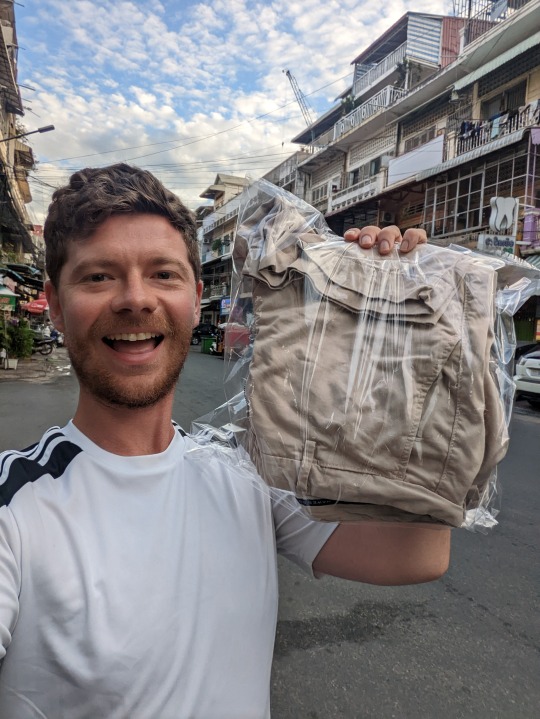

Our final adrenaline fuelled morning saw everything that could be late, or wrong, be late or wrong. My inventory on my laundry bag from the previous evening turned up one set of shorts missing. I high tailed it over to the laundrette at opening for operation "rescue my only other pair of shorts" before we had to dash I'm the other direction to catch our bus to Phnom Penh. Stress levels not helped by the only Tuk Tuk driver in Phnom Penh who seemed to have less of an idea of where to go than us. Wrong turns, getting stuck in jams, and effectively adding 30 minutes and a bucket of undue worry to the journey. We eventually screamed "THIS IS FINE", jumped out in the middle of a frikking highway and sprinted to the bus terminal to make our bus. Phew
We'd remember Phnom Penh. It's hard to forget. But for now, we were moving on to Siem Reap.
0 notes
Text
Cambodian History (Part 41): The 1954 Geneva Conference
The Geneva Conference began on May 8th, 1954. There were delegations from the USA, USSR, China, France, Britain, Cambodia, Laos, and north & south Vietnam (Communist & anti-Communist respectively).
The main topic was the negotiation of settlements from the Vietnamese & Korean wars. Cambodia was very much a small side player here, but Sihanouk had instructed the delegates (Nong Kimny, Sam Sary & Tep Phan). When North Vietnam (backed by China) proposed to seat representatives of the Communist-dominated “resistance movements” from Laos & Cambodia (including the KPLA), the delegates were on their feet, objecting strongly. It became clear that this was a no-compromise issue for Cambodia, and Vyacheslav Molotov (USSR) & Zhou Enlai (China) persuaded Pham Van Dong (NViet) to drop it. An early victory for Cambodia.
By mid-July, the delegates had come to an agreement on most of the Indochina topics. But Sihanouk wasn’t happy with the final proposals. They guaranteed Cambodia’s neutrality - but he wanted the Viet Minh to completely withdraw, and the KPLA to be disarmed. The final proposals also prevented Cambodia from entering into a military alliance with any country.
Late-night debates ensued. But eventually, the Soviet & Chinese delegates pressurized the Vietnamese Communists to agree with Cambodia’s terms. Cambodia signed the final agreement on July 21st. Another victory for Cambodia.
Not long afterwards, Sihanouk came to an understanding with China and NVietnam. They both agreed to respect Khmer sovereignty, and Sihanouk promised that US military bases wouldn’t be set up in Cambodia.
The USA was not pleased with this, and they threatened to withhold all aid. But in 1955, they changed their mind, and promised large amounts of military assistance. They also pledged their support for Cambodia’s sovereignty and neutrality.
In 1955, Sihanouk attended the Bandung Conference. This was a conference of non-aligned nations. Here, he met with people such as Jawaharlal Nehru (first Indian PM), Ahmed Sukarno (first Indonesian president), and Josip Tito, and was hailed as a leader of the Third World anti-colonial struggle.
The Communist-bloc countries began to give aid on better terms than the USA or other capitalist countries. However, American aid was still larger than all the others combined.
#book: a short history of cambodia#history#military history#cold war#korean war#first indochina war#cambodia#king sihanouk#nong kimny#sam sary#tep phan#viet minh#kpla#geneva conference (1954)#bandung conference#communism
6 notes
·
View notes
Text

Hello, folks, my first fall semester at Harvard is over and I thought I would share what the readings in a semester at Harvard looked like. I will preface that I took a humanities-heavy course load as I'm planning to concentrate in English! I've broken each course's readings as I felt appropriate. As always, if y'all have any questions at all feel free to send me an ask -- I'm always more than happy to talk about my experiences in education!
Expos 20.242: Why Shakespeare (Expository Writing Req):
Required Texts
Hamlet by William Shakespeare
Macbeth by William Shakespeare
Ambition by Rachel Bridge
Research Paper Texts
Absalom, Absalom! by William Faulkner
Sing, Unburied, Sing by Jesmyn Ward
A Good Man is Hard to Find & Other Stories by Flannery O'Connor
English 10: Literature Today
Books
Sing, Unburied, Sing by Jesmyn Ward
Whereas by Layli Long Soldier
Never Let Me Go by Kazuo Ishiguro
The Hard Tomorrow by Eleanor Davis
Short Pieces
"Happiest Moment" by Lydia Davis
"Smithereens" by Aleksander Hemon
"Hill of Hell" by Laura van den Berg
"How Many by Bryan Washington
"Can a Woman Who is an Artist Ever Just Be an Artist?" by Rachel Cusk
"The Muse at Her Easel" by Zadie Smith
"The Embassy of Cambodia" by Zadie Smith
"The Mupandawana Dancing Champion" by Petina Gappah
"The Disaster Store" by Helen Phillips
"Face Time" by Lorrie Moore
Freshman Seminar 40P: Appraising and Reimagining Middle and High School Math Education
Books
The Teaching Gap by Stigler and Hiebert
Excerpts from Reign of Error: The Hoax of the Privatization Movement and the Danger to America's Public Schools by Diane Ravich
Supplemental Readings
"Views on High School Mathematics Education"
"A Mathematician's Lament" by Paul Lockhart
"A Brief History of American K-12 Mathematics Education in the 20th Century" by James Royer
"Do the Math!" by David Wilson
"Why are Finland's Schools Successful?" by LynNell Hancock
"The Economic Impact of the Achievement Gap in America's Schools" by McKinsey and Company
"Achievement Gap Between White and Black Students Still Gaping" by Laren Camera
"Can Public Schools Fix the Achievement Gap? Yes, but They Won't." by Peter Sacks
"Reframing the Achievement Gap" by Robert Evans
"Closing the Opportunity Gap in Mathematics Education" by NCTM
"Summer Can Set Kids on the Right - or Wrong - Course" by Jeff Smink
"What Doesn't Meet the Eye: Understanding and Addressing Racial Disparities in High-Achieving Suburban Schools" by Ronald Ferguson
"An 82% Failure Rate on High School Algebra Exam?" by Stuart Anderson
"Rethinking 'Algebra for All'?" by Edward Silver
"The Myth of 'I'm Bad at Math'" by Miles Kimball and Noah Smith
"Building Thinking CLassrooms in Mathematics" by Peter Liljedahl
"No Child Left Behind Has Been Left Behind" by Lauren Camera
"The Math Wars" by Alan Schoenfeld
Various Math Curricula (including the Common Core)
#college#studying#studyblr#studygram#study#reading#english major#education#education degree#english degree#ivy league#harvard#studynwrite
38 notes
·
View notes
Text
Lara Croft's Biography
This is my attempt at consolidating Core Design's two biographies for Lara Croft as well as Crystal Dynamics' revised version for Legend into one, cohesive background story that includes all key events from her past adventures. Certain elements of the first nine games and their backstories are bound to be included in the new, unified timeline so any Reboot fans that are not as familiar with Classic Lara may find this interesting to read :) Hope you like it!

Name: Lara Croft
Nationality: British
Date of Birth: 14 February 1968
Birthplace: Wimbledon, London
Marital Status: Single
Blood Group: AB-
Height: 1,75m
Weight: 58 kg
Hair Colour: Brunnette
Eye Colour: Brown
Distinguishing Features: 9mm Handguns
Bio
Lady Lara Croft is an 11th generation Countess. The Croft family was granted the title and rights to Abbingdon, Surrey by King Edward VI in 1547. The Croft Estates are comprised of three separate manor houses, two of which are maintained by the National Trust, and the third is home to Lady Croft.
Lady Croft herself has suffered several personal tragedies, including the deaths of both parents on separate occasions before she came of age. Reputably an accredited genius and Olympic-standard gymnast, Lady Croft is the focus of wild speculation and intense debate in both the scientific and political communities in addition to the popular press. Idealized and vilified in equal measure, she is perhaps one of the most fascinating and enigmatic figures of our time.
Lara Croft was born in Surrey's Parkside hospital on the 14th of February in 1968 to Lady Amelia Croft and the notorious archeologist Lord Richard Croft, the late Earl of Abbingdon. She was raised to be an aristocrat from birth, and had lived in luxury and security aloof from the world at large. Between the ages of three and six, she attended the Abbingdon Girls School, where it quickly became clear that she was an exceptionally gifted child.
At the age of nine she survived a plane crash in the Himalayas that took the life of her mother. In perhaps the first story of her prodigious indomitability, she somehow survived a solo ten-day trek across the Himalayan mountains, one of the most hostile environments on the planet. The story goes that when she arrived in Katmandu she went to the nearest bar and made a polite telephone call to her father asking if it would be convenient for him to come and pick her up.
For six years following the plane crash, Lara rarely left her father's side, traveling around the world from one archeological dig site to another. During this period she was ostensibly given a standard education from private tutors, but it would probably be more accurate to say she was her father's full time apprentice.
When Lara was fifteen, her father went missing in Cambodia. Extensive searches by the authorities and Lara herself turned up human remains that could not definitively be identified. Since Lord Croft's body was not officially recovered, Lara could not directly inherit the Croft title and Lara was thrust into a bitter family feud over control of the Abbingdon estates with her uncle Lord Errol Croft. Lara eventually won the legal battle, and took possession of her inheritance but at the cost of a deep rift in the Croft family that left her estranged from her living relatives.
At 16 she began studying at Gordonstoun, one of Britain's most prominent boarding schools where she discovered the mountains of Scotland. One day Lara came across a copy of National Geographic on the hall table. The front cover featured a familiar name - Professor Werner Von Croy. A respected archaeologist, Von Croy had once lectured at Lara's school to pupils & parents alike.
The experience had a profound effect on Lara, triggering a desire for travel to remote locations in search of adventure. In some ways Von Croy had become an inspirational figure for Lara. As Lara read further, she learned that Von Croy was currently preparing for an archaeological tour across Asia, culminating in a potential new discovery to be made in Cambodia. Unable to pass up this opportunity, she walked over to the desk & penned a letter to Von Croy. She Introduced herself and offered financial assistance in exchange for her place on the expedition. Von Croy's reply assured her that the territories were friendly and that he had ample experience to look after both his & Lara's well being.
Lara's company as an assistant would be welcome, as was the offer of such a generous cheque. He remembered Lara from his lecture - her incessant yet insightful questions had made quite an impression upon him. And so it was agreed that Lara would accompany Von Croy for the duration of the tour.
At 21, while in college, she was part of a team of aspiring archaeologists in charge of a dig in Paraiso, Peru. Her closest friends, Amanda Evert, aspiring anthropologist, and Anaya Imanu, engineer, among them. They were attempting to break through the tomb of the Queen of Tiwanaku. The expedition was cut short however, as a tragic accident led to the deaths of most of Lara's friends and colleagues, including Amanda, with Lara and Anaya emerging from the dig as the only two known survivors.
Lara probably should have died there, as most did, instead she learned how to depend on her wits to stay alive in hostile conditions a world away from her sheltered upbringing. Her experiences had had a profound effect on her and in that process transformed herself as well. Her Peruvian odyssey was both miraculous and enlightening, as the young woman not only survived, but gained a perspective on herself and the world that made her past appear shallow and naive. Out of the darkness of her ordeal, she saw her future reflected in a different light.
She felt profoundly that there was more for her in this life than the coddled existence that had become her numbing habit. Unable to stand the suffocating atmosphere of upper-class British society any longer, she realized that she was only truly alive when she was travelling alone. Over the eight following years she acquired an intimate knowledge of ancient civilizations across the globe. Despite this drastic life change, Lara still retains the essence of her upbringing - most notably with her polite, upper-class accent. She turned to writing to fund her trips.
While in England, Lara lives in a mansion in Surrey which she inherited many years ago. At one time she saw little use in it but now realises that, if nothing else, it is at least handy for storing all the artifacts she has acquired on her travels. She has also had a custom-built assault course constructed in the grounds for training purposes.
Lady Lara Croft has already eclipsed her father's career; as of this writing she is credited with the discovery of some fifteen archeological sites of international significance. These sites are still yielding new and exciting insights to the past on an ongoing basis. No one can deny Lady Croft's incredible contribution to the field of archeology, however she is not without her detractors.
Lara's methods have been frequently called into question by government officials and other practicing archeologists. She has been described variously as anything from cavalier to downright irresponsible. Some scholars have suggested that her notorious lack of documentation and brute force methodology have contaminated countless sites and done more harm than good. There have even been (unsubstantiated) allegations that Lara actually takes items from these sites before informing the international community of their locations, and that she is nothing more than a glorified treasure hunter.
Despite the tabloid press's infatuation with her, Lara Croft guards her privacy with complete determination. She has never granted an interview nor made any personal comment to any of the rumors associated with her, preferring to express herself through brief formal statements given by the family solicitors, Hardgraves and Moore.
Predictably there have been a number of unofficial biographies printed about the young Countess, that attribute wild and fantastic feats to her exploits, ranging from the discovery of living dinosaurs in the Congo to infiltrating the infamous Area 51 in Nevada. The official line from the Croft Estate to these works is simply that "...these books are utter rot: disgraceful, trashy works of total fiction."
Nevertheless if you even make a cursory search on the Internet for the Unexplained, the Mysterious and the Downright Unbelievable, time and again you will find Lara Croft's name appearing. She appears to be a hero to conspiracy theorists and alternate history aficionados alike.
It seems the further you dig into Lady Croft's life, the more bewildering and mysterious she becomes. Perhaps like the archeological sites she discovers, we have only scratched the surface of this incredible woman and the complex and inscrutable secrets buried deep within her.
Lara Croft became the seeker of truths, both large and small, and in that pursuit she continues to this day.
Employment
Lara doesn't consider tomb raiding as a job, merely a way of life - although she has been known to uncover archeological artifacts on commission. To fund her radical lifestyle, Lara writes travel books. Titles so far have included 'A Tyrannosaurus is Jawing at My Head' and 'Slaying Bigfoot'. Her common complaint though is that she doesn't have enough time to put pen to paper.
As well as uncovering many notorious archeological sites - including the Atlantean pyramid and the last resting place of the dagger of Xian, Lara has found fame in other areas - she has driven the dangerous Alaskan Highway from Tierra del Fuego in South America in record time (although this was later denounced by the Guinness Book of Records due to her "reckless driving") and she hit the headlines again when she hunted out and killed Bigfoot in North America.
Sports
Not much of a team player. Discovered rock climbing while at Gordonstoun and used to set off into the hills alone during netball practice. Also took up shooting as an extra-curricular activity but was instantly banned for showing "too keen an interest'. However, the strength that climbing gave her fingers was to become useful when she started pulling triggers for real.
Music
Lara was brought up to appreciate classical music but having been a guest on U2's Popmart tour, has since become a fan of their music. She has also been introduced to the sounds of Nine inch Nails by her Aunty and considers it "good easy listening". Finds trance music, in general, good for training.
Food
Despite being a proficient cook from her days at finishing school and having sampled most of the exotic delicacies of the world, Lara usually opts for beans on toast when at home.
Hobbies
Any challenging sports. Has a particular interest in experimenting with different, often extreme forms of transport. Has also once admitted to stitching a kind of Bayeaux tapestry of her own adventures while at home.
Ambition
With her unique physical abilities, Lara is certain of being able to break many world athletic records and so sees no challenge in this herself. Her main ambitions still lie in the undefined world of tombs and the past. She has also however, developed a personal regard for Brian Blessed's attempts to climb Everest. If he never succeeds, she is determined to piggy-back him up there.
Heroes
All the great ancient figures who respected themselves enough to design such intricate tombs to be buried in. "Nobody goes to trouble like that anymore..."
Fears
Her Aunty's Corgi which has bitten her on several occasions - about which, for once, there is little she can do.
Lucky Charm
Any gun at hand.
14 notes
·
View notes
Photo

Today In History Zadie Smith is an amazing author, essayist, and short-story writer, who was born on this date October 25, 1975, in London, England. Smith is the author of the novels White Teeth, The Autograph Man, On Beauty, NW and Swing Time, as well as a novella, The Embassy of Cambodia, and two collections of essays, Changing My Mind and Feel Free. She is also the editor of The Book of Other People. Zadie was elected a fellow of the Royal Society of Literature in 2002, and was listed as one of Granta's 20 Best Young British Novelists in 2003 and again in 2013. Known for her eccentric characters, savvy humour, and snappy dialogue which tackle the treatment of race, religion, and cultural identity, Zadie Smith became a sensation in the literary world. CARTER™️ Magazine carter-mag.com #wherehistoryandhiphopmeet #historyandhiphop365 #cartermagazine #carter #staywoke #zadiesmith #blackhistorymonth #blackhistory #history #books https://www.instagram.com/p/CkIqIlWrknU/?igshid=NGJjMDIxMWI=
#wherehistoryandhiphopmeet#historyandhiphop365#cartermagazine#carter#staywoke#zadiesmith#blackhistorymonth#blackhistory#history#books
25 notes
·
View notes
Text
DOMINANT THEMES AND STYLES LITERATURE
SOUTH EAST ASIA
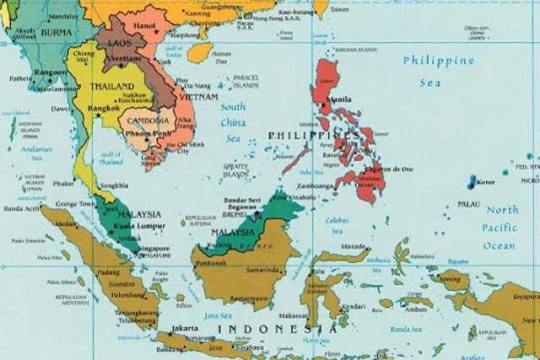
This area, which embraces the region south of China and east of India, includes the modern nations of Burma, Thailand, Cambodia, Laos, Vietnam, The Philippines, Malaysia and Indonesia. The earliest historical influence came from India around the beginnings of the Christian era. At a later period, Buddhism reached mainland Southeast Asia. Its influence was a major source of traditional literature in the Buddhist countries of Southeast Asia. Vietnam, under Chinese rule, was influenced by Chinese and Indian literature. Indonesia and Malaysia were influenced by Islam and its literature. All of the countries, except for Thailand, underwent a colonial experience and each of the countries reflects in its literature and in other aspects of its culture the influence of the colonizing power, including the language of that power. Education in the foreign language was to bring with it an introduction to a foreign literature and this, in turn, was to have considerable impact upon their modern forms of literary expression. One finds, then, all the well-known literary genres of Western literature, the novel, the short story, the play, and the essay. Poetry had been the most popular form of the traditional literature over the centuries but was rigid in form. However, through increased acquaintance with Western poetry, the poets of Southeast Asia broke the bonds of tradition and began to imitate various poetic types. A reading list of books is included.
EAST ASIA

Thinkers of the East is a collection of anecdotes and ‘parables in action’ illustrating the eminently practical and lucid approach of Eastern Dervish teachers.
Distilled from the teachings of more than one hundred sages in three continents, this material stresses the experimental rather than the theoretical – and it is that characteristic of Sufi study which provides its impact and vitality.
The emphasis of Thinkers of the East contrasts sharply with the Western concept of the East as a place of theory without practice, or thought without action. The book’s author, Idries Shah, says ‘Without direct experience of such teaching, or at least a direct recording of it, I cannot see how Eastern thought can ever be understood’.
SOUTH AND WEST ASIA

Chicana/o literature is justly acclaimed for the ways it voices opposition to the dominant Anglo culture, speaking for communities ignored by mainstream American media. Yet the world depicted in these texts is not solely inhabited by Anglos and Chicanos; as this groundbreaking new book shows, Asian characters are cast in peripheral but nonetheless pivotal roles.
Southwest Asia investigates why key Chicana/o writers, including Américo Paredes, Rolando Hinojosa, Oscar Acosta, Miguel Méndez, and Virginia Grise, from the 1950s to the present day, have persistently referenced Asian people and places in the course of articulating their political ideas. Jayson Gonzales Sae-Saue takes our conception of Chicana/o literature as a transnational movement in a new direction, showing that it is not only interested in North-South migrations within the Americas, but is also deeply engaged with East-West interactions across the Pacific. He also raises serious concerns about how these texts invariably marginalize their Asian characters, suggesting that darker legacies of imperialism and exclusion might lurk beneath their utopian visions of a Chicana/o nation.
Southwest Asia provides a fresh take on the Chicana/o literary canon, analyzing how these writers have depicted everything from interracial romances to the wars Americans fought in Japan, Korea, and Vietnam. As it examines novels, plays, poems, and short stories, the book makes a compelling case that Chicana/o writers have long been at the forefront of theorizing U.S.–Asian relations.
ANGLO -AMERICA AND EUROPE


ANGLO - AMERICA
The Division of Rare and Manuscript Collections has considerable holdings in Anglo-American literature from the 17th century onward, with notable strengths in the 18th century, Romanticism, and the Victorian and modern periods. Among the seventeenth-century holdings is a complete set of the Shakespeare folios, and works by John Milton and his contemporaries. Eighteenth-century highlights include near comprehensive printed collections of Jonathan Swift and Alexander Pope, and substantial holdings on John Dryden, Samuel Johnson, Joseph Addison, Sir Richard Steele, William Cowper, Fanny Burney, and others. Related materials include complete runs of periodicals, such as the Spectator and the Tatler.
EUROPE
The history of European literature and of each of its standard periods can be illuminated by comparative consideration of the different literary languages within Europe and of the relationship of European literature to world literature. The global history of literature from the ancient Near East to the present can be divided into five main, overlapping stages. European literature emerges from world literature before the birth of Europe—during antiquity, whose classical languages are the heirs to the complex heritage of the Old World. That legacy is later transmitted by Latin to the various vernaculars. The distinctiveness of this process lies in the gradual displacement of Latin by a system of intravernacular leadership dominated by the Romance languages. An additional unique feature is the global expansion of Western Europe’s languages and characteristic literary forms, especially the novel, beginning in the Renaissance.This expansion ultimately issues in the reintegration of European literature into world literature, in the creation of today’s global literary system. It is in these interrelated trajectories that the specificity of European literature is to be found. The ongoing relationship of European literature to other parts of the world emerges most clearly at the level not of theme or mimesis but of form. One conclusion is that literary history possesses a certain systematicity. Another is that language and literature are not only the products of major historical change but also its agents. Such claims, finally, depend on rejecting the opposition between the general and the specific, between synthetic and local knowledge.
Africa

African literature has origins dating back thousands of years to Ancient Egypt and hieroglyphs, or writing which uses pictures to represent words. These Ancient Egyptian beginnings led to Arabic poetry, which spread during the Arab conquest of Egypt in the seventh century C.E. and through Western Africa in the ninth century C.E. These African and Arabic cultures continued to blend with the European culture and literature to form a unique literary form.
Africa experienced several hardships in its long history which left an impact on the themes of its literature. One hardship which led to many others is that of colonization. Colonization is when people leave their country and settle in another land, often one which is already inhabited. The problem with colonization is when the incoming people exploit the indigenous people and the resources of the inhabited land.
Colonization led to slavery. Millions of African people were enslaved and brought to Western countries around the world from the sixteenth to nineteenth centuries. This spreading of African people, largely against their will, is called the African Diaspora.
Sub-Saharan Africa developed a written literature during the nineteenth and early twentieth centuries. This development came as a result of missionaries coming to the area. The missionaries came to Africa to build churches and language schools in order to translate religious texts. This led to Africans writing in both European and indigenous languages.
Though African literature's history is as long as it is rich, most of the popular works have come out since 1950, especially the noteworthy Things Fall Apart by Chinua Achebe. Looking beyond the most recent works is necessary to understand the complete development of this collection of literature
LATIN AMERICA

Latin American literature consists of the oral and written literature of Latin America in several languages, particularly in Spanish, Portuguese, and the indigenous language of America as well as literature of the United States written in the Spanish language. It rose to particular prominence globally during the second half of the 20th century, largely due to the international success of the style known as magical realism. As such, the region's literature is often associated solely with this style, with the 20th Century literary movement known as Latin American Boom, and with its most famous exponent, Gabriel Garcia Marquez. Latin American literature has a rich and complex tradition of literary production that dates back many centuries
Bocar, Mark Jason P.
Stem 11- St. Alypius
8 notes
·
View notes
Text
Hanoi, Vietnam
Day 165 – Luang Prabang to Hanoi, Vietnam
I spent my final morning in Luang Prabang at Joma Café, a delicious bakery/café that my uncle Alan had recommended, run by a Canadian expat! I was surprised (and very excited) that the café served Canada’s famous Nanaimo Bar, and picked up one to have a ‘taste of home’ along with my coffee. I tucked into a cozy booth for several hours, doing research and bookings for the final 5 weeks of my trip, including Vietnam, Cambodia, Bangkok and Japan.
In the late afternoon, I packed up my bag and headed to the town centre to hire a Tuk Tuk to take me to the airport. At this point in Southeast Asia, I had become pretty used to negotiating a price when taking a Tuk Tuk, and agreed upon a price with the driver. However, he ended up demanding a higher price at the airport, after we had arrived. Even after months of travel, I was still never quite sure what to do in these situations, which occasionally arose. Given the increased charge that the driver demanded was little more than 50c Canadian, it felt petty to argue over such a small amount. At the same time, the whole practice also felt dishonest, and I struggled with it in principle – particularly wondering in the back of my mind whether I was a target of arbitrary price increases because I was a woman travelling alone. Irritated but not wanting to argue, I grudgingly paid the full amount and headed into the airport to catch my flight to Hanoi.
After a short flight to the east, I touched down in Vietnam just as the sun was setting. Having secured my e-visa to the country in advance, I sailed through customs and into the arrivals hall, where I had pre-arranged an airport transfer to take me into the old town of the city. While I generally preferred to take public transit or hail a tuk-tuk when backpacking, I had become cautious with my transportation when arriving at airports after dark. From my research on Hanoi, I had heard that taxi scams are unfortunately common, where certain drivers are paid by hotels and hostels to drive unwitting passengers to the wrong location, or charge excessive fares, to the point where a passenger would need to go to an ATM, or pay in foreign currency. In the communication I had received in advance from my hostel in Hanoi, I had also been fully briefed on possible scams in transit, and chose to pre-pay for a transfer to avoid the worry. I had also purchased a new Vietnamese SIM card in the airport, so that I could ensure I could follow my route to the old town city.
As my ride pulled away from the airport, we were almost immediately surrounded by scooters – hundreds of them! Weaving in and out of traffic, the drivers leaned heavily on their horns as they navigated their scooters along the road - carrying everything from tall plants, flowers and produce, and sometimes up to 3-4 people! After the quiet atmosphere of Luang Prabang, where honking was rare in the old city centre, the streets of Hanoi were quite the opposite, bursting with sounds from every direction. Heading South, we crossed the Red River and approached the Old Quarter of the city.
As it happened, even with my pre-arranged airport transfer, my driver still tried to drop me off at the wrong hostel. Fortunately I had already located my correct destination in Hanoi on Google Maps, and after much back-and-forth, and insistence on my part, I was finally taken to the correct destination. The streets of the old quarter are so narrow that cars cannot go down them, and I walked the final few minutes to my hostel on foot. I passed other hostels with live music, and food vendors with plastic stools arranged near their stalls for people to sit and eat. My friends from Vancouver, Kevin and Liane, had previously stayed at this hostel, Original Backpackers, a few years earlier, and recommended it highly – and rightly so! I felt immediately welcomed by the friendly staff, and began to relax again after many hours in transit. After several weeks of communal living, I had decided to pay a small premium for a private room, where I had a long, hot shower, before crashing immediately for the night.
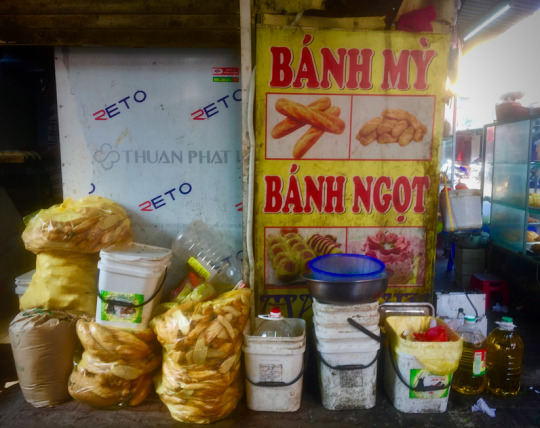
Typical Food Stalls in the Old Quarter
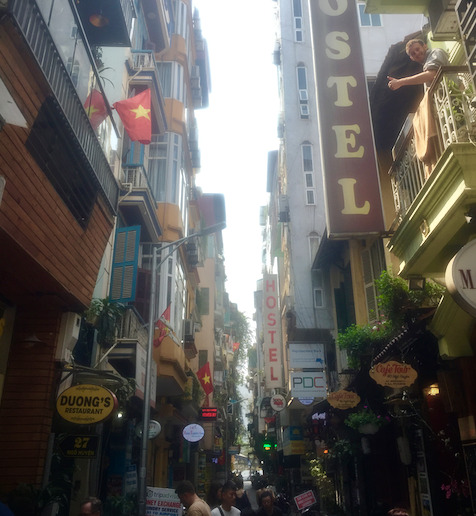
Narrow Streets in the Old Quarter, with a perfectly placed photobomber!
Day 166 – Hanoi
I only had one full day in Hanoi – and woke up early, determined to pack in as much as possible! Through the front desk of my hostel, I arranged a motorbike “Backstreet Tour” for that afternoon, where a local Vietnamese guide would take me around the city on a motorbike to show me both popular sites, and what day-to-day life looked like in Hanoi.
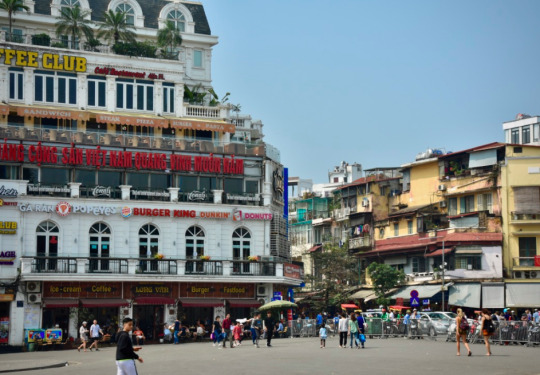
In the morning, I began to wander the Old Quarter of Hanoi nearby to my hostel. This historic city has been inhabited for over a thousand years, and has been shaped by a complex history – from ancient kingdoms, dynasties and wars, French colonialism, Japanese occupation during the second world war, to more recently, with the influences of communism and the Vietnam War. After the war ended in the 1970s, it wasn’t until 1990s that the country began to open up to the outside world again, bringing in new opportunities for tourism and economic development. Modern day Hanoi is home to a multi-cultural community with strong French, Chinese and Russian influences. French colonial architecture continues to be visible throughout the city, with some streets resembling historic neighbourhoods in Paris. Near the Old Quarter, a large gothic cathedral constructed by French still stands; St. Josephs is one of the first structures built by the colonialists as they expanded their reach into Southeast Asia. Remarkably, the cathedral is still in good condition despite the wars of the last century.
The Old Quarter, part of a former citadel wall, is made up of a narrow series of alleys, tightly packed together. The historic area is known for its clusters of workshops, skilled craftsman, artisans and guilds, with the 40 streets of the area each named for the primary good and service provided on each street. It was a lively place to wander through in the morning; locals sat down on low, colourful plastic stools set up by street vendors, eating a breakfast of noodles. Honking scooters whizzed up and down the alleys, narrowing dodging each other. I spotted a few people playing chess in a doorway, right next to a vendor selling produce off the back of a scooter. I passed through one street mostly selling flowers, before turning the corner to find another street with almost all bamboo products.
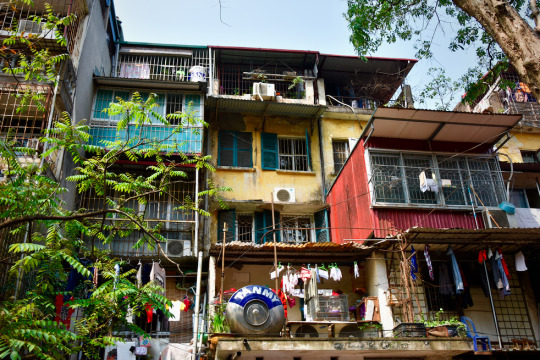
I wandered further east to Hoan Kiem Lake, finally making an attempt to cross a major street – with scooters, cars and pedestrians going in every which way! One good piece of advice I had been given by friends who had visited Hanoi was to simply walk out into traffic at a slow, steady pace (without any sudden moves or stops!) and the scooters would simply weave around you. I walked beside locals crossing on my first few attempts, but it wasn’t long before I got the hang of it!
I stopped at Note Coffee to try my first Vietnamese-style egg coffee. This drink is traditionally prepared by beating egg yolks with sugar and milk, and bringing this mixture to a boil, before pouring in coffee. The result is a foamy, dessert-like coffee – and was delicious! The café itself was also unusual – with its walls decorated with thousands upon thousands of colourful post-it notes, with messages from previous visitors. The result made the entire café look like a giant art installation, and reminded me of Yayoi Kusama’s dotted “obliteration room”. Sufficiently loaded up on sugar and caffeine, I continued onwards towards the lake, popping into a few art galleries and stalls on my way. Along the streets, I was constantly amazed by the number of vendors selling fruit, art, and countless other items off the back of their scooters. Pushing or driving their laden motorbike through the crowds, these vendors would make sales right, left and centre – all while keeping moving!
Arriving at the banks of Hoan Kiem Lake, I crossed a traditional, red wooden bridge to Ngoc Son Temple, located on a small island in the middle of the lake. Aside from the crowds of other tourists, it was a quiet respite from the buzz of the surrounding Old City of Hanoi.
As it was approaching noon, I returned to my hostel to meet Kien, my local guide for the afternoon motorbike tour. Slightly younger than me, Kien had grown up in Hanoi, and was excellent company for the afternoon. His motorbike was a vintage, army-green, “Minsk”, a heavy duty motorbike that was brought back from the Soviet Union in the 80s. As luck would have it – I was the only person on the tour that day, which allowed Kien to take me out and around the city for almost 7 hours! I could scarcely believe that I was able to see and experience so much of Hanoi in a day.
Kien first took me to Train Street, where twice a day a speeding train passes through the Old Quarter, mere feet from the front stoops of people’s homes. We continued onwards to Hanoi’s notorious black market, where vendors sell everything from car and mechanical parts to appliances, DVDs and electronics. Kien pointed out things as we cycled; the dense scramble of black electric wires overhead called “black noodles” by the locals; the French colonial architecture throughout the city; and the “tube houses” of the Old Quarter – narrow homes that exchanged their width for height and depth – as a way of lowering property tax, since the wider your house, the more you pay! Many of these tall, skinny homes had large water cannisters mounted on the top of the buildings, used to maintain water pressure. We also visited a few wet markets – where every imaginable item was for sale, from a rainbow of produce to live turtles, eels, and frogs.
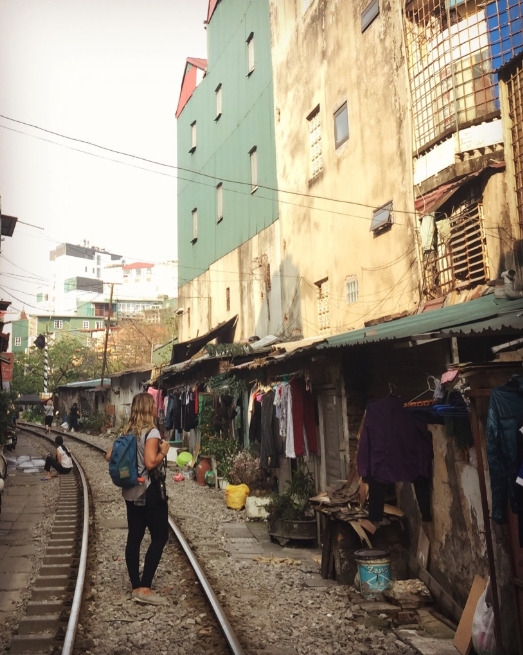
Train Street
Between our ventures into different areas of the city, Kien took me to many local restaurants and wet markets along the way, to try a wide range of different Vietnamese food, including more Ca Phe Trung (egg coffee), Banh Mi Chao (a hearty breakfast skillet), Banh Cuon (rice rolls, stuffed with pork), Pho Cuon (fresh beef rolls), Pho, and Banana Flower Salad. We also stopped at a tiny Bia Hoi right stand next to the road – “Bia Hoi” literally translating to “fresh beer”, and is draught beer that is sold on street corners and tiny bars throughout the city. It is delivered daily and is tapped straight out of a large steel barrel. Kien and I sat on tiny red plastic stools on the pavement, sipping the light beer and snacking on roasted peanuts from a nearby vendor.
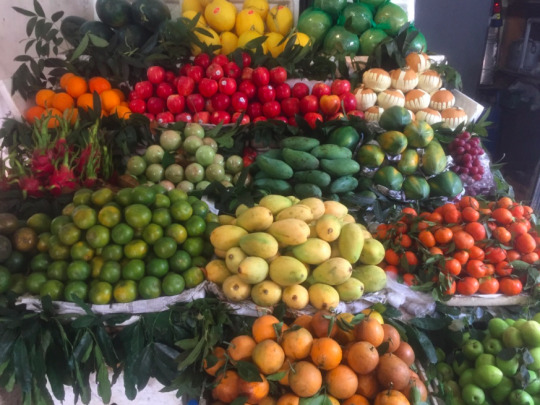
Fruit Markets

A typical neighbourhood Bia Hoi Stand
A particularly interesting part of the day is when Kien took me East of the city center to the banks of the Red River. I was able to walk along Cau Long Bien, a colonial-era cantilever bridge that was heavily bombarded during the Vietnam war, as it was a key point of connection between Hanoi and the nearby port. Spanning a mile and a half in length, it is still one of the longest cantilever truss bridges in the world. While only part of the original bridge still stands, the bridge continues to be a symbol of pride for the Vietnamese people. Underneath the Cau Long Bien, impoverished families live in a cluster of floating homes, make-shift shelters that have been built on rafts of plastic barrels.
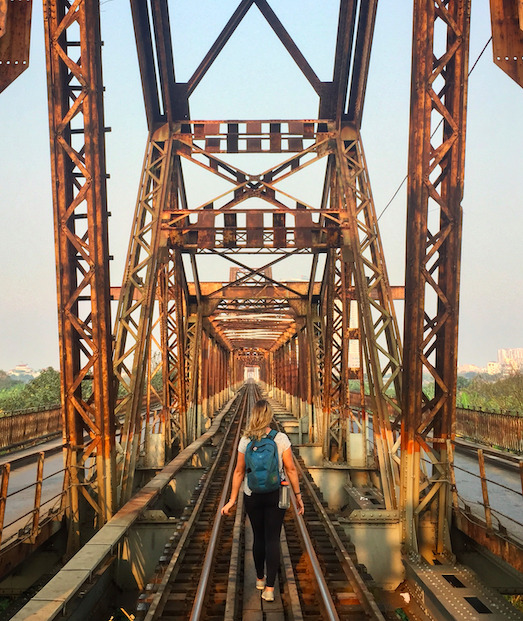
Cau Long Bien

Floating Homes on the Delta
We continued onwards to Bai Giua, or “Banana Island”, an island located in the middle of the Red River next to Hanoi. Since this island is on a flood plain, no apartments or concrete buildings are allowed, and the island is mostly used for farming, including fields of bananas and papayas. Kien maneouvered his motorcycle down a maze of dirt paths between the fields as we explored the island. Barking dogs sometimes came up to our motorcycle, and ran along next to us for a while, before dropping off the trail again. We passed by many farmers working in the fields, typically wearing a conical, straw hat, (called “Non La”) tied around the wearer’s chin with a piece of cloth. These multi-purpose hats not only protect farmers from the fierce tropical sun, but can be used as a fan and also as a basin for water.

As the sun began to set over the Red River, we headed back into Hanoi, and drove along the large, tree lined boulevards around the Ho Chi Minh Mausoleum and the Presidential Palace. Our day ended with a bit of a surprise - as Kien’s motorcycle broke down in the middle of an intersection! Fortunately, this seemed to be a common-enough occurrence in Hanoi, and all the other bikes moved around us seamlessly as we tried to get off the road. All in a day’s adventure! Arriving back in the Old Quarter after a terrific day of exploring Hanoi, I quickly crashed for the night, as I would be waking up early the following morning to catch a bus into the Sapa Mountains, a day’s journey northwest of Hanoi.
1 note
·
View note
Link
It is 42 years already since the fall of the Khmer Rouge regime!
45 years ago, on 17 April 1975, the Khmer Rouge (KR) regime took power, lasting until 6 January 1979. At least 1.7 million people are believed to have died from starvation, torture, execution and forced labor over those three years, 8 months, and 20 days. In order to find justice and reconciliation for the victims, The Extraordinary Chamber in the Courts of Cambodia (ECCC) began in 2006, after 9 years of negotiations between the Royal Government of Cambodia and the United Nations. The role is to prosecute senior leaders and those most responsible for crimes committed during the KR regime.
Four primary cases have been investigated at the ECCC since it began, with some divided into parts. At the time of writing, Case 001, Case 002/1 have passed final verdicts, Case 002/2 is under appeal and some are ongoing.
Outreach programs in Transitional Justice
It is around 10 years since the ECCC in Cambodia began hearing its first case. At the beginning of proceedings, updated information is shared by the ECCC with non-NGOs in Cambodia through outreach programs, so that updates on each case reached people living in remote areas. Outreach platforms used different methods but very often they included the voice of vitcim. Survivors shared their experiences in the KR regime at the ECCC or NGO-led forums, regardless of whether they are Vietnamese, Cham or Khmer. Some outreach programs include documentary short films or television programs on the KR regimes.
As the court is located in Cambodia, members of the broader public are able to attend proceedings. Based on Public Affairs Outreach Figures 2009 to 2017, there have been 55,129 participants so far in programs run by the court, including court visits, study tours, and 98,230 students attending school lectures.
The ECCC is the first international court in which victims have had the opportunity to participate in the process of procedure. In the Internal Rules of the ECCC, victims are able to file complaints before the ECCC, and they can be recognized as a Civil Party if they suffered harm during the regime.
From my observations, while survivors often become emotional when speaking about the past, they also feel that younger generations need to know and learn from the past to prevent genocide in future.
In the “Justice and Reconciliation for the Victims of the Khmer Rouge?” report, a survivor said : “I feel believed as I was given a chance to give testimony about what I have been through during a very cruel regime, I feel relieved that I can show the younger generation they must not allow this type of regime to happen again.”
The survivors are witness who can tell the youth that this regime happened, even if they don’t know much about the structure at the top levels or the overall strategy of the regime. They can at least describe their experiences and how they suffered. In this way, it is a supplement to the ECCC’s findings.
After many years working in this field, I am used to hearing the opinion from survivors that their children do not believe them because, they say, “Khmer could not kill Khmer.” During outreach programs and discussions, the question often is raised: “why did they killed Khmers? Why do they need to force people to work hard? Why did they have to evacuate people from one place to another?” Thus, the young people need to gain understanding and to hear more about what happened during this regime from different perspectives. However, although 45 years has passed since this regime began, it can still be hard for survivors to break their silence. It remains hard to recall the past.
In our interview with Soeung Phearak, a media reporter, he said “I used to hear about the Tribunal [the ECCC] from the television or radio but I never heard what my mum faced during the Khmer Rouge regime. I really want to hear what my mum suffered during the Khmer Rouge regime, but she always skipped over what happened…She is the most important evidence of what she suffered.”
How the ECCC contribute to the history education in formal education?
Article 65 of the Cambodian Constitution, in the chapter on Education, Culture and Social Affairs, declares that the state shall “promote the right of the citizen to a quality education at all levels and shall take every measure to progressively make this education available to all the citizens.”
The history of KR regime is delivered in the existing curriculum in high schools. As the textbook was created prior to the beginning of public hearings, it does not currently include any information taken from the tribunal.
In order to promote the history of Cambodia during the KR regime, a reparations project was included in the judgement of Case 002/1, which proposed the “inclusion of a chapter on forced population movement and executions at Tuol Po Chrey within the Cambodian school curriculum”. Since this curriculum update is on-going it is supplemented by Documentation Center of Cambodia Programs (DC-Cam). DC-Cam has compiled a history textbook, teachers’ guide book and other materials for lecturers in order to transfer knowledge to students across Cambodia.
The ECCC process in each case is slow and thorough, from the investigation process through to the verdict. Thus, the materials or evidence used during proceedings and written in those judgements is often extensive. In the Pre-Trial Chamber approximately 1,000 documents in Khmer French and English were put before the Chamber and subject to examination. It was no different in Case 002/01, with approximately 5,824 pieces of documentary evidence include documents, audio and video recording and written evidence witnesses, experts and Civil Parties. In Case 002/02, the documents subject to examination stretched to over 82,000 pages. These sources will be contained in archives like the Legal Documentation Centre, DC-Cam and Bophana Center, so that future generations and members of the public are able to access them.
On the topic of how of the ECCC passess knowledge to the youth, there are different opinions. Youk Chhang, director of the Documentation Center of Cambodia, was quoted in the Phnom Penh Post in 2018: “the ECCC is a court of law, not a history department,” he said, saying seeing the tribunal as a teaching tool “completely undermines” the years and millions invested in it. “Its legacy is justice… to prosecute the Khmer Rouge leaders.”
By contrast, Keo Duong, a history lecturer and member of the committee revising the text-book for formal education, explains that:
“Decisions in the judgement are based on multiple sources and evidence in order to make a careful conclusions. It is a solid reference for Cambodian history and of course, formal education. I’m now a member of history textbook writing committee. I write about the DK history for formal education and one of the sources I use is ECCC sources and judgements. For example, the lesson on S-21, the number of people who were at S-21, the crimes committed by top leaders, reports or primary sources that have been used in the court and so on.”
Conclusion
We urge the Ministry of Education and the relevant departments to include information from the ECCC and the existing curriculum as soon as possible, and to teach this in a critical way, so as not only to remember but also to understand.
6 notes
·
View notes
Text
The Way Things Ought To Be...
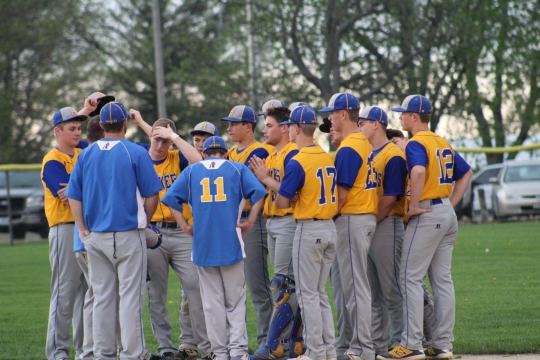
For some reason these photos look eerily familiar to the 2019 season
Before we embark on the 2021 Husker Baseball season, I feel it is important to take a look back and bring some closure to the 2020 season that might have been. The Huskers were returning several key starters to a team that finished 2019 with an outstanding record of 20-3, and I think that we can all agree that expectations for this group were at an all time high. But alas, it wasn’t meant to be, as the Coronavirus robbed these young men of what was sure to be a monumental season in the history of Higginsville athletics. But fear not, for I have been blessed with the uncanny ability to see not only what might have been, but also the way things ought to be. So please walk with me as we journey through space and time, and revisit the 2020 Husker campaign, through the eyes of an alternate universe….
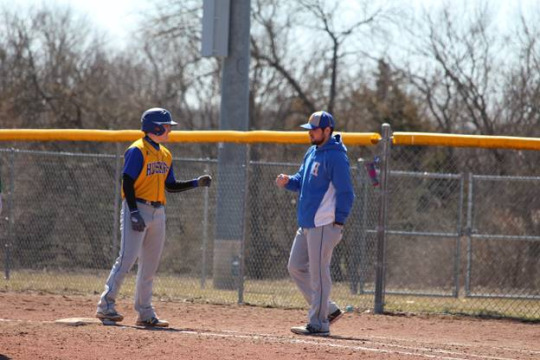
Coach Figg is so impressed with Nick Herrera’s sleeves, that it calls for a fist bump
Preseason
Coach Landon Figg embarks on his first campaign as head coach, and is immediately impressed with the talent and depth of his inaugural Huskers squad. Thirty-two players show up on the first day of training, and each and every one of them is equipped with full sleeves on their practice shirts. It is also important to note that not a single player is wearing “Hey Dudes” instead of their required baseball cleats. Drama is at an all-time low, and almost no one gets mouthy with the new skipper. It is obvious that senior leadership is taking control of the dugout.
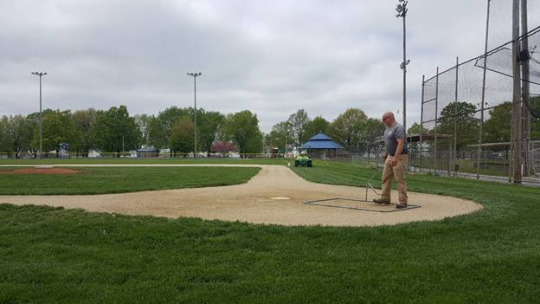
The old fences, before Higginsville went and got all fancy
Early Season
The Huskers get off to a hot start, posting victories in their first eight contests. They have outscored their opponents by an astounding 74-3 margin. Mason Rumsey, Mason Gash, Noah Iles, and freshman Cade Limback become the first players in Higginsville history to hit back to back to back to back home runs in a single game. Fans travel from miles around to marvel at the fences and dugouts at the newly renovated Fairground Park. They are also equally impressed with the size and quality of the Husker concession hotdogs. Everyone agrees that it is hands-down the best bang for your buck in the entire conference.
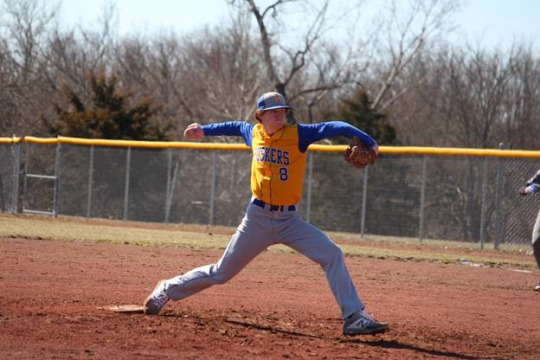
You can’t spell Noah Iles without several K’s
Mid-Season
Higginsville continues their torrid start by rattling off wins in their next 10 games, and stretching their streak to 18. Payton Boehm sets a school and state record by striking out 21 batters in a single game. But unfortunately the milestone was short lived, as Iles bested the feat two games later, handing out 22 K’s (he struck out four in one inning due to a player reaching first on a dropped third strike.) James Wilkson completes a personal best, by swiping four bases in one contest, while Dawson Kouril runs his season total to 14 outfield assists. Logan Warren hits a deep line drive to center field, but this year, instead of hitting the fence, it clears the barrier by at least 50 ft. Jonah Dotson and Ethan Rankin each pitch in with pinch hit walk-off doubles to seal Husker victories. But probably most impressive of all, is the fact that the Higginsville coaching staff never had to remind a single player to go after a foul ball.
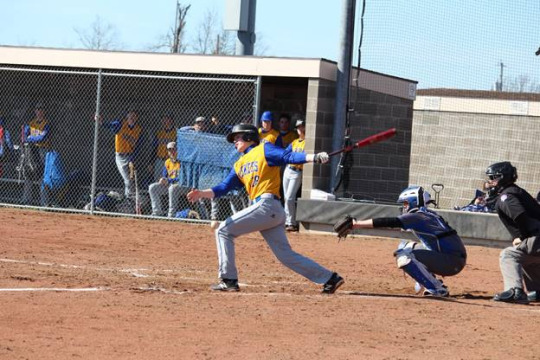
Records were made to be broken
Late Season
The Huskers finish their regular season campaign with a perfect record of 25-0, winning the Conference title. Mason Gash sets the school record for most home runs in a season (21) and career (whatever that math comes out to be). Jace Kerley prompts the creation of a new category in the record books, by being hit by a pitch 42 times. Nick Herrera finishes the season with an on base percentage of .800, due to an average of two free passes per game. Cade Limback, Josiah Golden, and Jackson Kouril share rookie of the year honors, while Iles and Boehm are co-Cy Young award winners. The Huskers pitching staff of Iles, Boehm, Kouril, Kelan Ernst, and Garrett Pemberton, combine to sport a ridiculous 1.75 e.r.a. Coach Figg is forced to ponder his future, as multiple D1 coaching opportunities come pouring in.

Post Season
Higginsville does the unthinkable, by sweeping the post season and taking home the Huskers first ever baseball state championship. And to make the victory that much sweeter, they bested Lamar 18-0 in the championship game. There were accolades galore, as the Huskers swept the all-conference and all-district awards. And in an unprecedented move, MSHSAA decided to name the entire varsity squad as All-State. Mayor Knehans declared May 31st as annual Husker Baseball Day, and a massive parade was thrown in the team’s honor. Even the Shriners made an appearance as they used to do in the previous Higginsville parades. There were Shriner clowns, Shriners on horseback, Shriners in ridiculously small cars, Shriners just walking and throwing candy, Shriners on motorcycles, Shriners playing bagpipes, Shriners on a pirate ship float, and oh yeah, tractors, lots of farm tractors. It was truly a sight to behold, and one that will live in Husker lore forever.
Where are they now?
The 2020 class had several contributing seniors, all of whom will be missed at Fairground Park. Let’s take a quick look at where I imagine a few of them might be now.
Dawson Kouril
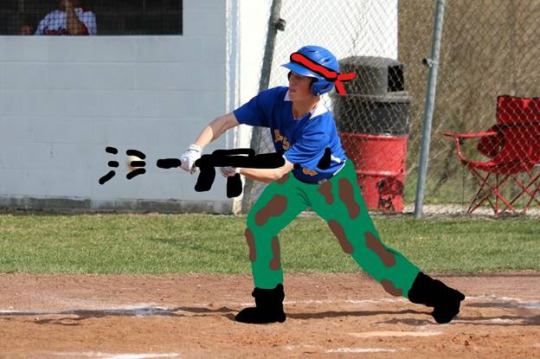
After high school, Dawson joined the Marine Corps and worked his way into special forces. He was last seen in the jungles of Cambodia, training freedom fighters in the use of left-handed weapons.
Noah Iles

Noah Iles is currently undergoing rigorous training in his bid to become a valet at the Gateway Foundations first ever space hotel, set to open in 2027.
Payton Boehm

Payton Boehm grew his hair out, started his own religion, and is currently growing “medicinal” marijuana on a commune in Boulder, Colorado.
James Wilkson
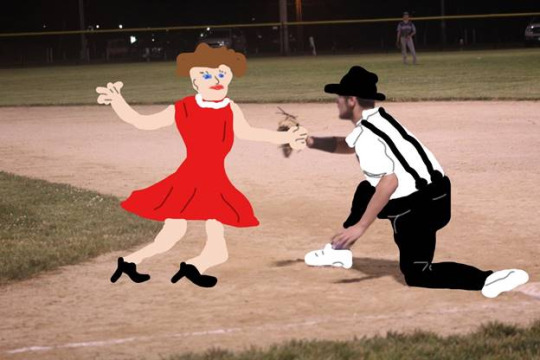
James Wilkson decided to take his talents to Hollywood, and make a name for himself on the big screen. You can catch him on season 73 of “Dancing with the stars.”
Mason Gash
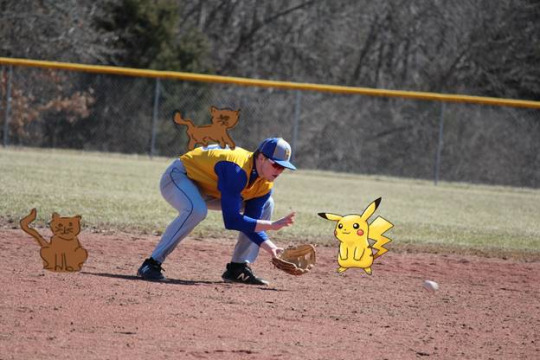
Mason is single and lives at home with his sixteen cats. He enjoys collecting Beanie Babies and considers himself a master of Pokemon Go.
I know, it’s a lot to process, and amazing that these guys have accomplished so much in just a few short months out of high school. Of course, absolutely none of this is true, and it’s all just a figment of my bizarre imagination and sense of humor. Please do not send the health department to Mason Gash’s home, I am certain that he has no more than one or two healthy pets. In all seriousness, these young men are all doing great and I’m sure will be moving on to bigger and better things in their future. I really enjoyed watching them throughout all of their Husker athletics, and each of them deserved to finish out their senior year on their own terms. But since their high school career was ended so abruptly, I just felt that it was important to acknowledge them one last time, and bring some closure to the great 2020 season that might have been. Covid-19 has affected each and every one of us in one form or another, whether it be through lost opportunities, or the unthinkable, the loss of a loved one. For me, the return of baseball is almost therapeutic, and hopefully signals a return to some sort of normalcy. I appreciate you taking the time to read this ridiculous article, and look forward to better times ahead for all of us.
1 note
·
View note
Photo









HOLOCAUST MEMORIAL WEEK
Highest rated films* about genocide & crimes against humanity I have watched
The Act of Killing (2013) - 95%
One of the most eccentric films I have seen and it is also one of the films where the perpetrators of genocide have been interviewed.
First They Killed My Father (2017) - 87%
The incredible story of Loung Ung, the child soldier and survivor of Khmer Rouge, has shown me the horrific part of history in Cambodia. Angelina Jolie’s directorial work is truly a masterpiece, and she has a strong personal connection to Cambodia.
Hotel Rwanda (2004) - 91%
As it is known as the African Schindler’s List, it is extraordinary to know the story of a man who risked everything to protect not only his family, but over a thousand Tutsi and Hutu refugees. The theme song ‘Nobody Cares’ depicts the time where the authorities did nothing to stop the genocide, which driven by hate and fear. It also one of the influences for my poem about the survivor’s experience in the Rwandan genocide.
Life is Beautiful (1997) - 80%
What I love about this film is the lightheartedness, which made the film unique out of the Holocaust films despite of the negative criticism. I was shocked to see Guido die off-screen after he made sure his son stays in the game in order to protect him. Life is Beautiful is one of the foreign films to achieve the financial and critical status. It is also one of my favourite European films as well.
Night and Fog (1955) - 100%
I watched this documentary, as a case study, for learning about emotional response and spectatorship in my A Level course in Film Studies. The images, which I haven’t seen in Holocaust books, did shock me as much as the audiences have back in 1955. It is considered to be one of the best documentary short films.
The Pianist (2002) - 95%
This film made a shocking and horrifying depiction of the Holocaust in Poland in Władysław Szpilman’s perspective. It is a brave move for Roman Polanski to direct the film as he was a Holocaust survivor. He was offered to direct Schindler’s List but declined as he was haunted by his personal experiences and suffered the loss of his mother. The most incredible part of Szpillman’s story is when he was discovered and asked to play the piano by the Nazi officer. Then suddenly the officer helped him during the final days of the war.
Rabbit-Proof Fence (2002) - 87%
The film Australia (2008) gave me a glimpse of Australian history, which is the Stolen Generations. The relations between the whites and Aboriginals led to the government creating a unfair policy, which caused family separations and the decline of Aboriginal culture. I found the story about the girls, determined to walk a thousand miles back home, is remarkable. One of the girls did get taken again, along with her two daughters. This led to her daughter and herself writing her story.
Schindler’s List (1993) - 97%
Before I saw the film, I remember reading the book about Holocaust when I was young as ten while I was in boarding school. It didn’t frighten me as I was shocked that the most horrific part of history was exist. Schindler’s List is the first genocide film I watched when I believed to be 12 years old. Despite of the film’s rating, I was shocked and terrified by the scene where the Schindler Jews were forced to dig up and burn the bodies. I love the themes and symbolism especially the use of black and white, and the girl in red. When I watched Spielberg (2017), it revealed that when Steven Spielberg was young, he denied his Jewish heritage because of prejudice due to living in the non-Jewish neighbourhood. While he worked on Schindler’s List, it helped him reconnect to his heritage. The film will always be one of his greatest works.
Waltz with Bashir (2008) - 96%
This is the first and only animated feature length documentary in the history of animation. The animation, which are flash animation and traditional animation, is very unique at the time of release. I chose this film as one of my case studies for my essay on European animated films during my final year at university. It is amazing that Ari Folman, the director, took his journey to regain his repressed memories of the war by interviewing former soldiers. There is a shocking twist in the ending where Folman discovered that he fired flares for the militia during the evening of the massacre, which he was unaware of. Then I see Muslim women wailing with grief and walking towards him. The use of the real footage of the aftermath of the massacre made the ending quite powerful, and I was shocked and moved by it when I saw it for the first time.
*rated in Rotten Tomatoes website
#holocaust#holocaust memorial#the act of killing#first they killed my father#hotel rwanda#life is beautiful#night and fog#the pianist#rabbit proof fence#schindler's list#waltz with bashir#riderj123
54 notes
·
View notes